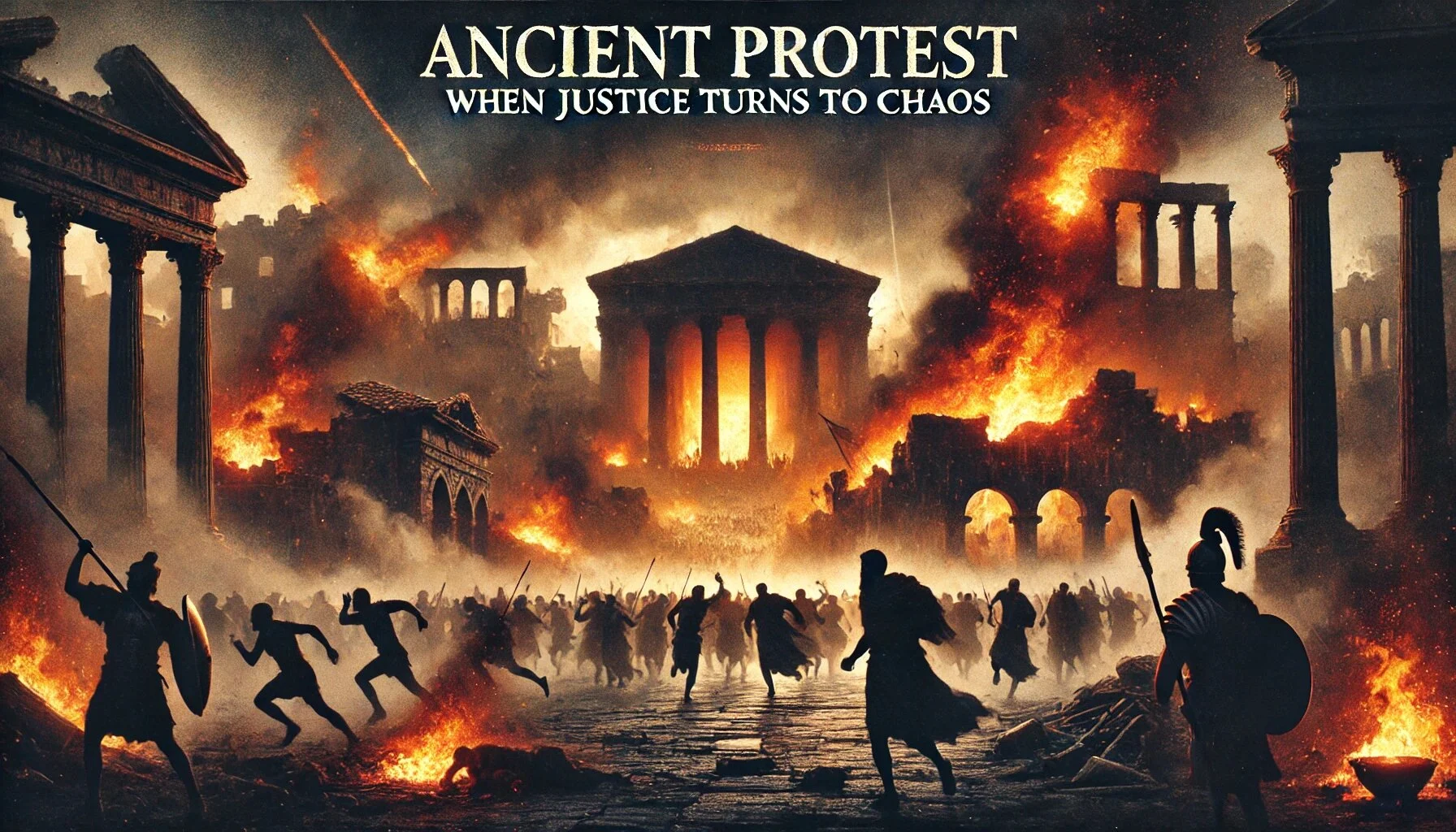Motives Matter with Ancient Protest
Protests have been used throughout history as a way for people to demand change, confront authority, and challenge injustice. Yet, not all protests are righteous. Some emerge from corrupt actions, deception, or lawlessness, leading not to reform but to destruction. Over the next few weeks, we’ll be examining Ancient Protest, to decide if protest motives brings justice or chaos.

A clear example of how a movement can escalate into lawlessness is found in Genesis 19. With the destruction of Sodom and Gomorrah and the events surrounding the fall of these cities. We will show what happens when a protest is fueled by wickedness instead of justice.
What began as a collective demand in Sodom quickly turned into a riot. The people insisted their desires be accepted, no matter the consequences. Their actions led to blindness, confusion, and the destruction of their entire civilization.
When Ancient Protest Becomes a Riot
Protests usually start with a demand for change, but purpose and execution separates a just protest from a destructive one. In Sodom, the people were not protesting oppression, seeking fairness, or standing against corruption. Instead, they gathered together to impose their will, enforcing their desires through intimidation and force.
When the mob outside Lot’s house demanded that the visiting men be brought out, it had already crossed into lawlessness. Their demands were not about defending rights, but about violating them. The lack of restraint, rejection of opposition, and insistence on control turned this protest into a riot.


Group Protests vs. Individual Stands
The story of Sodom and Gomorrah highlights an important difference between group-led protests and individual stands for justice. Group protests can be powerful, but when they lack discipline or a righteous cause, they quickly spiral into chaos. The people of Sodom acted as a collective, believing their numbers justified their actions. But when a group is driven by lawlessness, the consequences are always catastrophic.
On the other hand, individuals who stand for truth often face opposition but hold the moral ground. Lot stood alone against the mob and refused their demands. Even though he was just one man against an entire city. This contrast of morality can be seen throughout history, where some protests lead to destruction, while others bring real change.
Motives Define the Movement
Ancient Protest Motives Define the Movement
Advocates must take every protest seriously, no matter how large or small. The actions behind a movement decides whether it will bring reform or ruin. Too often people jump to support a protest without questioning its motives. While relying on mainstream broadcasters or social media influencers to shape their opinions. But the reality is, broadcasters are human, and their conclusions are shaped by their own motives.
Public voices do not always get it right. Many have financial incentives, political biases, or personal interests that influence how they report events. Just because a protest is loud and widely covered does not mean it is just.
Before standing behind a movement, individuals must ask.
- Does it seek justice, or does it seek dominance?
- Is it built on truth, or is it fueled by manipulation?
- Does it unite people for a cause, or does it pressure them into submission?
Sodom’s protest was not about fairness, it was about control. The people were not seeking equality but instead demanding that their actions be accepted without resistance. This same pattern appears today, as many modern movements push agendas disguised as justice.
A protest without a foundation of truth does not bring justice. Instead, it destroys moral boundaries, creates division, and leads to disaster. Every movement must be examined carefully before being supported. When broadcasters, politicians, or activists refuse to allow questions about their cause. This is a sign that they are protecting an agenda and not seeking justice.
The Consequences of Ignoring Ancient Protest Warning Signs

Sodom’s downfall and it’s destruction is a warning to protestors who lose their moral foundation. This pattern is not limited to ancient history. For example, Family courts were first established in the early 20th century in the United States. They were designed to handle domestic relations cases, including divorce, child custody, and support. Initially, these courts were designed to protect families and ensure fairness in legal disputes. However, as the legal proceedings expanded, it became increasingly influenced by government policies and legal structures. This shifted the focus away from its original intent of the households well-being.
By the early 1900s, family courts were established in the states of New York and Chicago. With provisions for specialized attention to family-related legal matters. Over time, federal involvement and state regulations grew, influencing how these courts operated. What began as a system meant to resolve family disputes fairly soon became a tool of control.
Today, family courts infringe on parental rights and personal freedoms. This forces parents to comply with complex legal frameworks that prioritize revenue over family well-being. The system pressures individuals into cutthroat business practices and dishonest dealings just to survive. While being concealed under the pretense of legal compliance. What was once meant to help families stay together, now profits from their destruction. The people of Sodom ignored the warnings, confident that their power and numbers would protect them. But their movement ended with blindness, disorder, and destruction.
The same warning applies today, a protest is only as strong as its foundation. If built on deception and seduction, it will eventually crumble, dragging down those who blindly followed. The story of Sodom and Gomorrah is a reminder that not all protests lead to justice, some only lead to devastation. It is up to those who see the signs to speak out before it is too late.
Looking Ahead into Ancient Protest
The story of Sodom and Gomorrah shows what happens when a group-led protest spirals into lawlessness. However, not every protest ends in destruction. Some spark wars, others bring justice, and a few reshape history. Over the next few weeks, we will examine three powerful protests in the Bible. Each with high stakes, unexpected consequences, and lessons that still apply today.
Next week: A nation torn apart. A shocking act of protest sparks an all-out war. One man’s response to injustice forces leaders to take action, but the cost is greater than anyone expected.
The week after: A silent stand that led to war. One man refused to bow. His defiance spread beyond himself, forcing a king to intervene and setting cities on fire.
In three weeks: A one-man protest that changed everything. He sat quietly, making a whip. Then, He stood up and turned the tables—literally.
Each of these protests reveals something different about power, justice, and consequence. Some led to war, others to political upheaval, and one reshaped the very idea of righteousness.
Explore with Xtrusion Solution what drives a protest to succeed? What makes it spiral into chaos? So join us next week, as we look at one of the most disturbing protests in the Holy Bible.


